
© Railway Wonders of the World 2024 | Contents | Site Map | Contact Us | Cookie Policy


The Sekondi-Coomassie Railway
How the Sekondi-
RAILWAYS OF THE COMMONWEALTH -
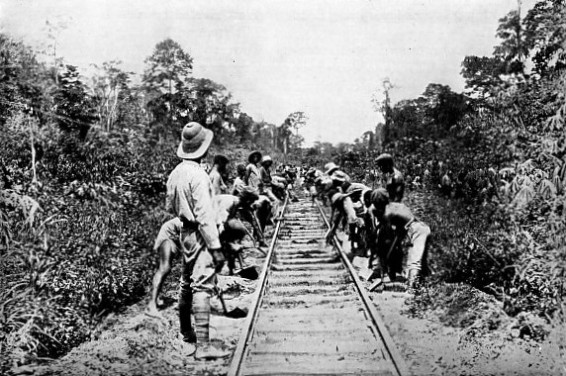
LEVELLING AND BALLASTING THE LINE. The work was done entirely by local labour.
WHILE every great railway possesses its individual romance, yet, tucked away here and there, in odd corners of the globe, are short isolated lengths of the steel highway which claim more than ordinary attention. Among these are the railways of West Africa, and in particular that of the Gold Coast, which possesses a romantic glamour which is peculiarly its own.
The popular conception of this section of the African continent is somewhat hazy. Generally it is dismissed as “The White Man’s Grave”, comprising vast tracts of dense, impenetrable, fever-
The idea of criss-
At that time West Africa was a veritable “Tom Tiddler’s Ground”, awaiting the coming of the capitalist and toiler. But the machinery of development could not be set in motion until facilities were offered for access to the interior. The shore of the Gold Coast is hemmed in by a thick belt of jungle, 150 miles or more in width. To venture into this huge, untrodden forest demanded no small amount of pluck and determination. The exotic vegetation presented a solid barrier, through which advance could be made only by hacking and cutting, since the jungle was intersected by very few, narrow, and tortuous paths, trodden down by the feet of the natives.
The railway conquest of West Africa was inaugurated with the dispatch of a survey party to Sierra Leone in 1893 by Mr. Shelford, the Colonial Office having decided to open up the hinterland. Actual constructional work was commenced in 1896. Step by step the railway, of 2 feet 6 inch gauge, was driven forward from Freetown until it had reached Pendembu, 230 miles up country, and a short distance from the Liberian frontier.
The first attempt to survey the unknown interior for the ribbon of steel proved disastrous. Three Englishmen started out to make the reconnaissance. The party comprised a surveyor, his assistant, and a doctor. The latter was indispensable, owing to the country’s evil reputation. Disease was more to be dreaded than any form of hostility or accident. The surface of the ground is carpeted with a thick layer of decaying vegetation -
The trio had not gone far before the formidable character of their undertaking was revealed very vividly. The swarming implacable insects counted their first victory: the doctor was bowled over by malaria. This was the sorriest trick that fortune could have played, and it was decidedly unnerving. Then the assistant fell a victim to the malady, and before the gravity of the situation was grasped he had crossed “The Divide”. It is not surprising that the surveyor himself, who had cheated misfortune, was dismayed by this calamity. His first care was the interment of his dead chum. He gave him as Christian a burial as the limited circumstances of the bush permitted. The provisions were tumbled out of the thin wooden boxes in which they had been packed for transport, and from these few sticks a crude coffin was contrived, in which the body was committed to a hastily-
It was the discovery of gold which prompted the construction of the first railway on the Gold Coast. Intrepid prospectors braved the pestilential forests and diligently panned the up-
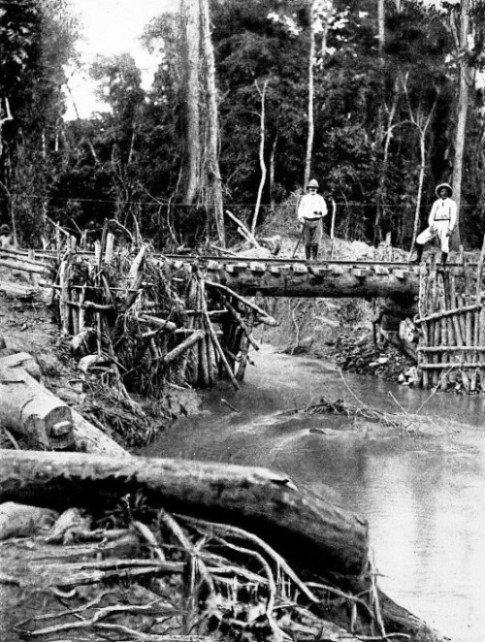
A TEMPORARY BRIDGE OVER THE SUYAM RIVER. This view shows the nature of the country through which the railway runs.
No industrial concern could work under such conditions and show a profit. Accordingly it was decided to drive a railway from a convenient point on the coast to Tarkwa. After scouring the shore line of the Gold Coast from end to end, it was decided to create a terminal port at what was virtually an unknown spot, which then was little more than a native village -
Having secured a foothold on the coast, the railway builders undertook to drive their line forward from that point. The first section comprised some 40 miles, but it was as hard a 40-
Yet the surveyors had painted the picture of what was to come very convincingly. Events proved they did not exaggerate the conditions one whit. They themselves had had many a stiff struggle to advance. Driving survey lines through a gloomy forest which is so dense and overgrown with brush that it is seldom a clear view 100 feet ahead can be obtained is despairing toil. The country was found to be gently undulating, but the majority of the depressions were filled with swamp or stagnant, fetid pools, concealed from sight by the overgrowing scrub, so that a sudden immersion to the thighs or waist was by no means uncommon; while such unseemly disturbance of a silent lagoon was sufficient to provoke dense swarms of mosquitoes to spirited attack.
In such country as this the man with the transit and level must be gifted with what the American terms aptly “a nose for a railway”, meaning an instinct, cultivated by prolonged and difficult experience, to obtain the best route in the shortest time and with the minimum of expense. When the outlook is shut in on all sides by dense vegetation, it is a toss-
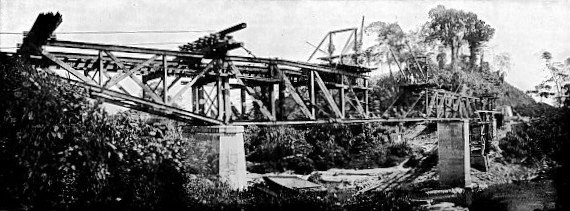
BUILDING THE ANCOBRA BRIDGE. The most important on the line. The central span is of 180 feet.
Surveying in tropical climes is attended with another factor which is not encountered in more temperate regions. The decided route or “location” is indicated by a row of pegs, spaced 100 feet apart -
The right-
While many of the larger trees are somewhat hollow and brittle, being analogous in this respect to the Canadian cottonwood, others are solid through the butt. Such a tree offers a pretty problem in its removal from the right-
The felling of the trees and the cutting of the luxuriant undergrowth was only one, and the easiest, half of the work. When brought to the ground the vegetation had to be destroyed, as it was useless for constructional purposes. The large trees were split, hacked to pieces, piled and fired, which, owing to the wet climate and the wood being green, occupied time. Then came reckoning with the stump. As with the majority of trees growing in a wet region, and where there is a thick upper layer of decaying vegetable matter, the roots do not thrust themselves very deeply into the subsoil, but rather radiate in all directions along the surface. The usual method of treating these obstacles was to dig around the stump, severing the roots, and then to haul the mass to one side by the aid of rope and tackle to be burned in due course. Though progress was somewhat slow under these conditions, it was preferable to blasting the stumps, as it enabled native labour to be used, whereas expert and highly paid skill would have been necessary.
Although the swathe through the forest is 300 feet wide, the windfall obstruction of the railway is not eliminated entirely. Indeed, the interruptions from this cause upon the Gold Coast number about two hundred per annum; falling trees constitute the worst foe against which the management is pitted. The tall giants, owing to indifferent root-
As the Gold Coast, from its hot, moist climate, is virtually a gigantic greenhouse, the undergrowth thrives amazingly. So much so that it is necessary to cut it back about twice a year; otherwise the permanent way runs the risk of being blotted out within a very short space of time. Thus the expense of clearing does not end with the initial operation; maintenance of the open space through the jungle is unavoidably expensive; in fact it represents a prominent item in the working costs.
As a rule when such a country is opened up by railway, a pioneer line is laid. Expense is kept down to the lowest possible amount, the engineers following the path of least resistance, reducing earthworks to the minimum as well as disregarding the elements of curvature and grade. Then, as the railway settles down and the traffic grows, elaborate overhauling is taken in hand and the line is rebuilt practically. This policy has been found to be the most successful and remunerative in the United States, Canada and Australia, but it has its drawbacks; re-
In the case of the Gold Coast Railway the guiding principle was “First cost: last cost”. True it made the bill for construction somewhat heavy, but the wisdom of the policy has been justified completely by results. No grades exceeding 1 in 50 or curves of a less radius than 330 feet were permitted. Some heavy earthworks became requisite at places, while some of the embankments are of large proportions. The rails, weighing 50 lb. per yard, are laid upon pressed steel sleepers -
Although a high-
The engineers were handicapped seriously by being compelled to carry every ounce of material required for the railway from the railhead, whence it was brought by train to the point of construction upon the heads of natives. On one, occasion the engineer was describing the methods which had been adopted to a party of interested gentlemen, among whom was an American. The latter was familiar with the procedure followed by railway builders in his own country, and that human heads should be utilised for transport purposes perplexed him keenly. He reflected for a few seconds, and then, determined to solve what to him was a quaint puzzle, he fired the inevitable “Why?”
“Oh! Because there was no other way!” was the retort.
“What?” ejaculated the astonished American. “Weren’t there any animals -
“No!” retorted the engineer blandly. “Only snakes and mosquitoes!”
The American was nonplussed, but he dismissed the Gold Coast as being a “Gol-
The disadvantage of building the railway from one end only was that as rapidly as an embankment was raised the rails had to be laid over it, no interval being permitted to allow settlement to take place. Inasmuch as the earthworks were built on treacherous ground, although the depressions were drained as far as practicable, and the ballast was little better than loam or silt, subsidences were frequent. When the wet season set in the new earthworks suffered heavily at places, the soft soil either being washed away, packing tightly, or spreading, thereby producing ominous “sink holes.” Further dumping and ballasting had to be carried out, the metals being lifted with jacks as the ballast was tamped beneath. To make matters worse, as the line approached the gold district, the mines, instead of shipping their material over the route followed before the coming of the railway, landed it at Sekondi and dispatched it to the railhead, whence it was transported overland. The result was that the railhead not only became choked with railway constructional material for the line, but also with goods for the mines.
As the railway penetrated the jungle the labour question became somewhat acute. The forest is practically tenantless. White labour was impossible, even if it had been available, from motives of cost and the susceptibility of the white man to the dreaded indigenous diseases. So a native recruiting campaign was inaugurated. The District Commissioners of the British West African colonies circulated appeals for labourers throughout their respective territories. At first the harvest was not very inspiring, but as the natives learned that the White Man’s money was certain and regular, and that fair treatment was meted out, while good food was provided, they accepted the opportunity to supplement their means of existence. The wages from the civilised point of view certainly were not princely, averaging a shilling per day with all found, but the native was perfectly satisfied. When work
was in full swing 16,000 natives found steady employment, 12,000 of whom were brought in from Lagos. Upon the completion of the railway this vast army, or those who preferred, were restored to their homes. The natives proved to be highly intelligent, and for the most part developed into good workmen. They were accommodated in large camps, which assumed such proportions, with serried rows of well-
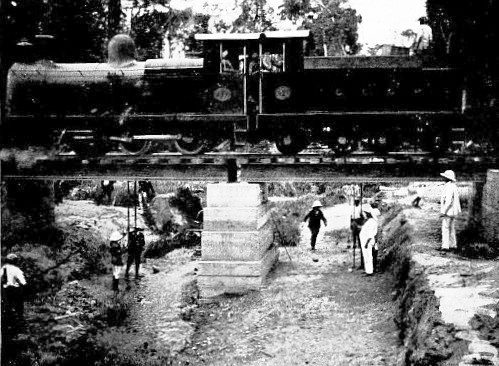
TESTING A BRIDGE ON THE GOLD COAST RAILWAY.
The natives proved tractable and, on the whole, were not so lazy as those found in other parts of the continent. Squads of natives were drilled to act as police, and they kept law and order in a perfect manner. Once a month the whole toiling population lined up round the engineer’s hut, gaily bedecked and dressed as if for a fete. In the hut was a table and one or two engineers, before whom the natives passed in a regular, well-
The cost of construction was inflated very appreciably owing to the distance of the railway from the purchasing markets. Every ounce of provisions, building material, and other necessaries had to be brought from England. The one item of freight was exceedingly heavy, many articles by the time they were landed at Sekondi having increased seven-
A vessel laden with supplies put out from Liverpool once every month while work was in progress. The commissariat was a heavy responsibility, bearing in mind the large army of toilers that had to be fed. But the arrangements were laid so carefully that no apprehensions ever arose under this heading, although now and again everything went awry from some unforeseen mishap, such as the total wreck of a supply steamer off the West African coast. Losses in landing at Sekondi, owing to the absence of harbour facilities, were considerable, but this was a drawback which could not be compassed. These misfortunes, however, affected the progress of the railway more adversely than the labourers. Several weeks’ delay ensued while duplicate orders of the lost material were being fulfilled at home and shipped.
As the railway was approaching Tarkwa in 1899 the first serious indication of native hostility to the white invasion became manifest. In April, 1900, King Prempeh rose in rebellion. The disaffection spread like wildfire. The engineers working on the advance works, or engaged in survey-
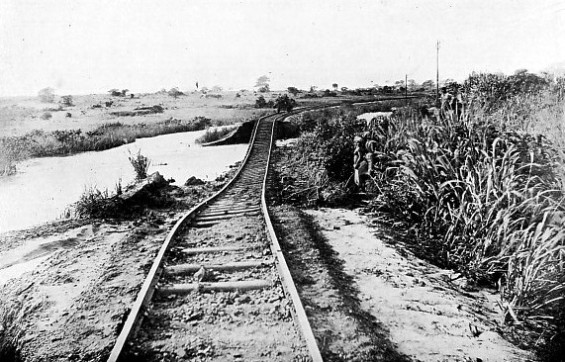
A CONSTANT MENACE TO SECTIONS OF THE GOLD COAST RAILWAY.
A wash-
In 1899, prior to the outbreak of the war, Mr. Frederic Shelford, who had taken over the reins of railway building operations upon the retirement of his father, and who inherited the pioneer’s enthusiasm in a vigorous railway expansion policy for the Gold Coast, matured plans for continuing northwards from Tarkwa to Coomassie. Prospectors scouring the country north of the existing gold district had discovered further deposits of the yellow metal. Mr. Shelford, having been on the spot, recognised the extent of this later discovery, as well as the possibilities of developing other resources which were lying dormant. Thus the moment was opportune for extension, and he communicated his views to the Right Honourable Joseph Chamberlain, who was then Colonial Secretary. The Minister was sympathetic, but a counter-
The survey between Tarkwa and Coomassie was undertaken by Mr. Frederic Shelford personally, and he started out with one assistant and fifty native porters. Progress was found to be even more difficult than it had been between the coast and Tarkwa. It was an endless tramp through a succession of evil swamps and dense jungle, where the rainfall is terrific, 4 or 5 inches of water being by no means uncommon in a single “tropical shower”. There was not a single native track to help Mr. Shelford. His compass was his sole guide, and he hacked and hewed his path foot by foot. In order that he should not be impeded in his reconnaissance, the personal impedimenta had been reduced to the scantiest necessities. No camp outfit was carried beyond a few utensils for the preparation of the food, and to filter and boil the drinking water. At the end of the day a small clearing a few feet in circumference was made, to allow the camp, such as it was, to be pitched, while the ground, with its damp pile of rotting vegetation, constituted their couch.
This expedition also met with misfortune. Mr. Shelford’s assistant was struck down by black-
The overthrow of the Ashanti king and the pacification of the country after its addition to the Gold Coast enabled the construction of the railway to be resumed, and in May, 1901, Tarkwa was linked to the coast. Then the development of the mines went forward with a rush. In one stroke the transportation charges were reduced from £40 to £5 per ton, and the effect was felt immediately. The heaviest machinery now could be brought up with ease and installed. Before many
months had elapsed the heart of the hinterland was a throbbing hive of activity.
There was no pause in railway-
So far as bridges are concerned, heavy works of this character were not found necessary. The most important, perhaps, is the Ancobra Bridge, on the branch line, 19 miles in length, which runs from Tarkwa to Prestea. This bridge has four spans -
The rolling stock is of the latest type. The locomotives follow the British design with American cow-
It comes as a surprise to the stranger to the Gold Coast, who is familiar with the railway travelling comforts of home, to find cars fitted with kitchens, sleeping-
The metamorphosis of West Africa constitutes one of the most remarkable incidents in railway history. In few other countries where maps were non-
This achievement is all the more remarkable when the difficulties concerning the personnel are borne in mind. The changes in the staff were everlasting, owing to sickness. During the progress of the work no fewer than ten chief engineers were appointed in turn.
Does the line pay? Well, whereas in 1905 the net receipts were £51,000, in 1911 the net earnings were £183,798. Such a result proves conclusively that the £1,857,237 sunk in the railway development of the Gold Coast is proving a highly profitable investment, which is certain to increase as the illimitable resources of the country are opened up.
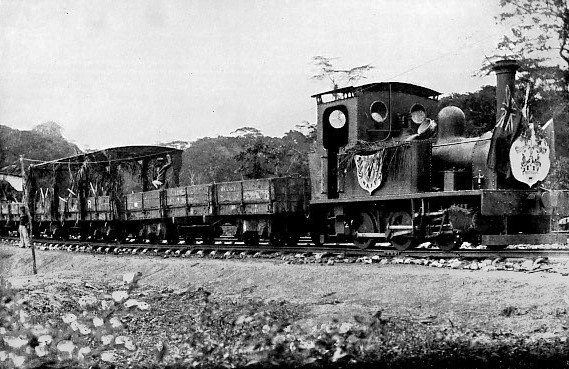
THE ARRIVAL OF THE FIRST LOCOMOTIVE IN COOMASSIE.
You can read more on “Across Africa by Rail”, “The Gold Coast” and “The Uganda Railway” on this website.